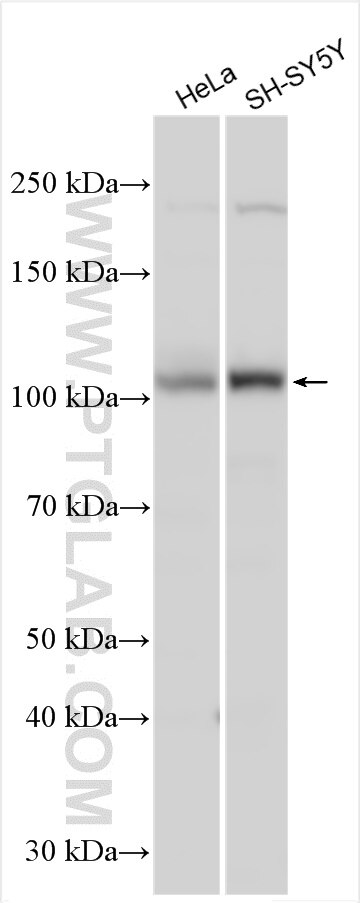- Featured Product
- KD/KO Validated
GTSE1 Polyklonaler Antikörper
GTSE1 Polyklonal Antikörper für IHC, WB, ELISA
Wirt / Isotyp
Kaninchen / IgG
Getestete Reaktivität
human, Maus, Ratte
Anwendung
WB, IHC, IF, ELISA
Konjugation
Unkonjugiert
Kat-Nr. : 21319-1-AP
Synonyme
Galerie der Validierungsdaten
Geprüfte Anwendungen
| Erfolgreiche Detektion in WB | HeLa-Zellen, K-562-Zellen, L02-Zellen, Mauslebergewebe, MCF-7-Zellen, Rattenlebergewebe, SH-SY5Y-Zellen |
| Erfolgreiche Detektion in IHC | humanes Leberkarzinomgewebe Hinweis: Antigendemaskierung mit TE-Puffer pH 9,0 empfohlen. (*) Wahlweise kann die Antigendemaskierung auch mit Citratpuffer pH 6,0 erfolgen. |
Empfohlene Verdünnung
| Anwendung | Verdünnung |
|---|---|
| Western Blot (WB) | WB : 1:1000-1:8000 |
| Immunhistochemie (IHC) | IHC : 1:50-1:500 |
| It is recommended that this reagent should be titrated in each testing system to obtain optimal results. | |
| Sample-dependent, check data in validation data gallery | |
Veröffentlichte Anwendungen
| KD/KO | See 3 publications below |
| WB | See 7 publications below |
| IHC | See 6 publications below |
| IF | See 1 publications below |
Produktinformation
21319-1-AP bindet in WB, IHC, IF, ELISA GTSE1 und zeigt Reaktivität mit human, Maus, Ratten
| Getestete Reaktivität | human, Maus, Ratte |
| In Publikationen genannte Reaktivität | human, Maus |
| Wirt / Isotyp | Kaninchen / IgG |
| Klonalität | Polyklonal |
| Typ | Antikörper |
| Immunogen | GTSE1 fusion protein Ag13497 |
| Vollständiger Name | G-2 and S-phase expressed 1 |
| Berechnetes Molekulargewicht | 77 kDa |
| Beobachtetes Molekulargewicht | 66-77 kDa, 100 kDa |
| GenBank-Zugangsnummer | BC006325 |
| Gene symbol | GTSE1 |
| Gene ID (NCBI) | 51512 |
| Konjugation | Unkonjugiert |
| Form | Liquid |
| Reinigungsmethode | Antigen-Affinitätsreinigung |
| Lagerungspuffer | PBS mit 0.02% Natriumazid und 50% Glycerin pH 7.3. |
| Lagerungsbedingungen | Bei -20°C lagern. Nach dem Versand ein Jahr lang stabil Aliquotieren ist bei -20oC Lagerung nicht notwendig. 20ul Größen enthalten 0,1% BSA. |
Hintergrundinformationen
GTSE1 is only expressed in the S and G2 phases of the cell cycle, where it colocalizes with cytoplasmic tubulin and microtubules. In response to DNA damage, the encoded protein accumulates in the nucleus and binds the tumor suppressor protein p53, shuttling it out of the nucleus and repressing its ability to induce apoptosis.
Protokolle
| Produktspezifische Protokolle | |
|---|---|
| WB protocol for GTSE1 antibody 21319-1-AP | Protokoll herunterladen |
| IHC protocol for GTSE1 antibody 21319-1-AP | Protokoll herunterladen |
| Standard-Protokolle | |
|---|---|
| Klicken Sie hier, um unsere Standardprotokolle anzuzeigen |
Publikationen
| Species | Application | Title |
|---|---|---|
Mod Pathol Expression profiling of small intestinal neuroendocrine tumors identifies subgroups with clinical relevance, prognostic markers and therapeutic targets. | ||
Mol Ther Nucleic Acids lncRNA LINC00665 Stabilized by TAF15 Impeded the Malignant Biological Behaviors of Glioma Cells via STAU1-Mediated mRNA Degradation. | ||
Cancer Sci High G2 and S-phase expressed 1 expression promotes acral melanoma progression and correlates with poor clinical prognosis. | ||
Lab Invest GTSE1 promotes prostate cancer cell proliferation via the SP1/FOXM1 signaling pathway.
| ||
Lab Invest GTSE1 promotes tumor growth and metastasis by attenuating of KLF4 expression in clear cell renal cell carcinoma.
| ||
Mol Carcinog G2 and S phase-expressed-1 induces chromosomal instability in esophageal squamous cell carcinoma cells and inhibits cell apoptosis through ROS/JNK signaling
|







